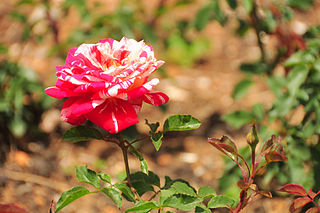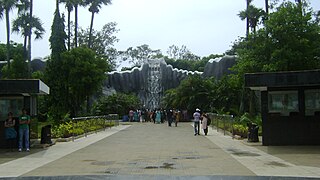
The Birmingham Botanical Gardens are a 15-acre (6-hectare) botanical garden situated in Edgbaston, Birmingham, England. The gardens are located 1+1⁄2 miles (2.4 km) south-west of Birmingham city centre at grid reference SP049854. Designed in 1829, the gardens are Grade II* listed in Historic Englands's Register of Parks and Gardens, and retain many original features and layout, which was designed by the landscape gardener and horticulturalist John Claudius Loudon. The site is notable for its range of glasshouses and gardens, which display a wide variety of plants and previously, birds. Birmingham Botanical Gardens is managed by Birmingham Botanical and Horticultural Society, a registered charity. The gardens are open daily to the public with paid admission.

The Atlanta Botanical Garden is a 30 acres (12 ha) botanical garden located adjacent to Piedmont Park in Midtown Atlanta, Georgia, United States. Incorporated in 1976, the garden's mission is to "develop and maintain plant collections for the purposes of display, education, conservation, research and enjoyment."

Ficus microcarpa, also known as Chinese banyan, Malayan banyan, Indian laurel, curtain fig, or gajumaru (ガジュマル), is a tree in the fig family Moraceae. It is native in a range from China through tropical Asia and the Caroline Islands to Australia. It is widely planted as a shade tree.
Hidden Lake Gardens colloquially known as Hidden Lake 755 acres (3.06 km2), is a botanical garden and an arboretum operated by Michigan State University situated in the Irish Hills of southeast Michigan. The Gardens are known for their large collection of native and nonnative trees, shrubs and flowers. HLG was given to Michigan State University by Harry Fee in 1945. Today it is visited by nearly 45,000 people annually. One facet of the Hidden Lake Gardens mission is "To preserve an undeveloped area of the scenic Irish Hills, providing a place of beauty and inspiration for public enjoyment."

The Government Botanical Garden is a botanical garden in Udhagamandalam, near Coimbatore (Ooty), Tamil Nadu state, India laid out in 1848. The gardens, divided into several sections, cover an area of around 22 hectares, and lie on the lower slopes of Doddabetta peak. The garden has a terraced layout. It is maintained by the Tamil Nadu Horticulture Department.
Gopalapuram is a prime residential locality in Chennai, Tamil Nadu, India. It is surrounded by Royapettah in the North and East, Mylapore in the South-East, Teynampet in the South and Thousand Lights in the West. It is located 17 km (11 mi) from the Chennai International Airport and 3 km (1.9 mi) from Chennai Central railway station. It is located in between Dr. Radhakrishnan Salai and Anna Salai. Avvai Shanmugam Road passes through Gopalapuram, dividing it into North Gopalapuram and South Gopalapuram. Gopalapuram comes under Chennai Central Lok Sabha constituency.

Phipps Conservatory and Botanical Gardens is a botanical garden set in Schenley Park, Pittsburgh, Pennsylvania, United States. It is a City of Pittsburgh historic landmark and is listed on the National Register of Historic Places.

The University of Michigan Matthaei Botanical Gardens includes botanical gardens, natural areas with trails, and several research-quality habitats and is part of the organization Matthaei Botanical Gardens and Nichols Arboretum. It was established in 1907.

Adenium obesum, more commonly known as a desert rose, is a poisonous species of flowering plant belonging to the tribe Nerieae of the subfamily Apocynoideae of the dogbane family, Apocynaceae. It is native to the Sahel regions south of the Sahara, tropical and subtropical eastern and southern Africa, as well as the Arabian Peninsula. Other names for the flower include Sabi star, kudu, mock azalea, and impala lily. Adenium obesum is a popular houseplant and bonsai in temperate regions.

Rashtrapati Nilayam formerly known as Residency House is the official winter retreat of the President of India located in Hyderabad, Telangana. was officially opened to the public in March 2023, allowing visitors to explore its vast grounds, thematic gardens, and architectural marvels. The President stays here for at least two weeks during their winter sojourn visit and conducts official business. It is also used as a guest house for visiting dignitaries. It is located in Bolaram in Secunderabad, a neighbourhood of Hyderabad.

Tholkappia Poonga or Adyar Eco Park is an ecological park set up by the Government of Tamil Nadu in the Adyar estuary area of Chennai, India. According to the government, the project, conceived based on the master plan for the restoration of the vegetation of the freshwater ecosystems of the Coromandel Coast, especially the fragile ecosystem of the Adyar estuary and creek, was expected to cost around ₹ 1,000 million which will include the beautification of 358 acres of land. The park's ecosystem consists of tropical dense evergreen forest, predominantly comprising trees and shrubs that have thick dark green foliage throughout the year, with over 160 woody species, and comprises six vegetative elements such as trees, shrubs, lianas, epiphytes, herbs and tuberous species. The park was opened to public by Chief Minister M. Karunanidhi on 22 January 2011 and named after the renowned Tamil scholar Tholkappiar. About 65 percent of the park is covered by water and artefacts and signages. In the first 2 months of its inauguration, nearly 4,000 children from several schools in the city and the nearby Kancheepuram and Tiruvallur districts have visited the park to learn about wetland conservation, eco-restoration and water management. While the first phase of the ecopark covered about 4.16 acres of CRZ-III area, the entire area covered under the second phase falls under this category.

Indoor bonsai are bonsai cultivated for the indoor environment. Traditionally, bonsai are temperate climate trees grown outdoors in containers. Tropical and sub-tropical tree species can be cultivated to grow and thrive indoors, with some suited to bonsai aesthetics shaped as traditional outdoor or wild bonsai.

Ficus aurea, commonly known as the Florida strangler fig, golden fig, or higuerón, is a tree in the family Moraceae that is native to the U.S. state of Florida, the northern and western Caribbean, southern Mexico and Central America south to Panama. The specific epithet aurea was applied by English botanist Thomas Nuttall who described the species in 1846.
Madhavaram Milk Colony is a neighbourhood in northern Chennai, a metropolitan city in Chennai district in the Indian state of Tamil Nadu.

The Government Rose Garden is situated on the slopes of the Elk Hill in Vijayanagaram of Ooty town in Tamil Nadu, India at an altitude of 2200 meters.

Arignar Anna Zoological Park, also known as the Vandalur Zoo, is a zoological garden located in Vandalur, Chennai, India, about 31 kilometres (19 mi) from the Chennai Central and 15 kilometres (9.3 mi) from Chennai Airport. Established in 1855, it is the second public zoo in India. It is affiliated with the Central Zoo Authority of India. Spread over an area of 602 hectares, including a 92.45-hectare (228.4-acre) rescue and rehabilitation centre. The zoo houses 2,553 species of flora and fauna across 1,265 acres (512 ha). As of 2012 the park houses around 1,500 wild species, including 46 endangered species, in its 160 enclosures. As of 2010, there were about 47 species of mammals, 63 species of birds, 31 species of reptiles, 5 species of amphibians, 28 species of fishes, and 10 species of insects in the park. The park, with an objective to be a repository of the state's fauna, is credited with being the second wildlife sanctuary in Tamil Nadu after Mudumalai National Park.
As of 2019, there are 632 parks in Chennai City, including 142 parks in the north zone, 224 in the central zone, and 266 in the south zone. They range in size from 700 square metres to 5,000 square metres. A couple of the parks, including the Anna Nagar Tower Park, are spread across acres. In 2018, the city's green cover was estimated to be 14.9 percent, up from an estimated 4.5 percent in 2011. The per capita green cover of the city has been estimated at 8.5 square meters, as against the World Health Organization recommendation of 9 square meters of green cover per capita in cities. The city lost around 100,000 trees in December 2016 because of Cyclone Vardah. As of 2018, the city's tree cover is estimated to be around 64.06 sq km. This is just over 15 percent of the entire city. The most dominant species of trees in the city are copper pod, Indian beech, neem, gulmohar, raintree, and tropical almond. The overall extent of open space in the city is 34.58 km2. In all, the city has 121 species of trees belonging to 94 genera and 42 families. Teynampet zone remains the most diverse with 68 species, and Manali zone with just 38 species is the least. With 51 parks, Adyar remains the zone with the highest number of parks in the city, and Tiruvottiyur zone scores the least with only 4 parks. The share of Chennai's greenspace is dominated by the Guindy National Park, with an area of 2.71 sq km, which covers a vast area south of the Adyar River.

The Bali Botanic Garden is the largest botanic garden in Indonesia and is located in the mountainous region of Bedugul, Tabanan Regency, central Bali, around 90 minutes drive north of Denpasar. The Garden was established on 15 July 1959 and is situated around 1300 metres above sea level overlooking Bratan Lake and the Ulun Danu Temple on the slopes of Tapak Hill. The Garden is a centre for botanical research, conservation, education and recreation. It is operated by the Indonesian Institute of Sciences (LIPI).
Madhavaram Botanical Garden is a botanical garden in Chennai, India, set up by the horticulture department of the Government of Tamil Nadu. The garden, the second botanical garden in Chennai after the Semmoli Poonga, is the largest botanical garden in the city.
Kalaignar Centenary Park is a world class park situated at Gopalapuram neighbourhood in Chennai, Tamil Nadu in India.




















